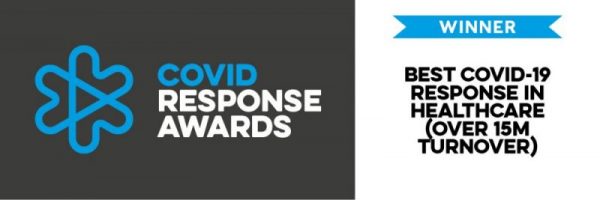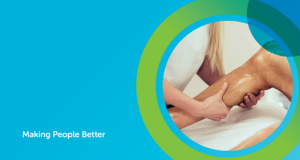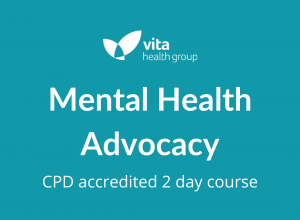This website can help you understand what persistent pain is and offers tips, advice and information to help you self-manage your condition and enjoy a better quality of life.
What is Persistent Pain?
Persistent pain (sometimes called chronic or long-term) is described as ‘pain that continues for three months or more and may not respond to standard medical treatment’. It is quite common, affecting around one in seven of us, and can be caused by a longstanding condition, like arthritis, or as a result of a specific problem. Persistent pain can also develop gradually, sometimes for no obvious reason, and may even come on some time after an activity or injury.
Persistent pain can be felt in a specific part of the body such as back, shoulder or leg(s), or throughout the body. The pain may be continuous or vary in its level – sometimes flaring up or getting worse very quickly while at other times being easier to manage.
What is going on when people have persistent pain?
Persistent pain is different to short acting ‘acute’ pain and often doesn’t respond to usual treatments. This is because the problem is with the pain system itself, rather than being related to a specific problem in the body. Think of the pain system as a computer – with microchips and processors (like our brain and spinal cord), and wires (our nerves). If parts of the computer go wrong – a faulty chip or crossed wire – it stops working properly. In the pain system, this means we experience persistent pain when there is no real reason for it.
Why do people develop persistent pain?
There is still a lot that is not understood about why pain can continue after injuries heal, or why it can be present without any physical problem. Studies suggest some people are born with genes that make them more vulnerable – in other words some are unlucky and more prone to developing problems in their pain systems.
How does persistent pain make people feel?
Living with persistent pain can be stressful and can affect people in lots of different ways. Managing at home, work duties and dealing with friends and family can be difficult. People often feel they have no control over the pain and are unable to cope with it. Experiencing pain can lead to feelings of anxiety or fear about what might be causing the pain and what the future might hold. This is usual for many people, especially where there is no obvious cause. Feeling pain can also make you feel tense, especially if you expect the pain to come back or get worse. You may feel easily angered and hostile towards people that don’t understand your situation or how your pain affects you. Some people even feel anger towards the pain itself.
When things aren’t going so well, it can lead to troubling thoughts
You may feel hopeless and very down about feeling this pain, which can result in depression. The pain itself or worrying about it may cause difficulties with sleeping. Being tired and having a sleepless night can make you feel more upset and bad tempered. But it’s not all bad news and there are many things you can do to live a full life, despite your pain.
What can you do about persistent pain?
At the moment we don’t have a cure for persistent pain, and some patients may have to accept that this is a condition they have to live with long-term. The good news is you can learn skills that can help you to better manage your condition.
Some become so good at managing their pain that it fades completely into the background for much of the time. Everyone is different so the right plan will vary from person to person.
Self-managing persistent pain can involve learning how to do things differently and the right treatments and medicines, as well as learning to think and react differently to the pain, and life events in general.
Isn’t my GP supposed to fix my pain?
Sadly, this is unrealistic as there is no magic ‘cure’. For many of us, pain will be an unwelcome visitor in our lives and we need to accept it and find the best way to deal and live with it. It is important to work with your GP and other healthcare providers to develop a Pain Management Plan
Is having both pain and depression usual?
It is quite common to experience depression while suffering with persistent pain, but there are many things you can do to help including:
- Exercise
- Medication – speak to your GP about treatment options
- Talking about it to others – via support groups or talking therapies
Why is it I do too much on good days and less on bad ones?
This is very familiar problem – commonly known as the Boom and Bust cycle. Pacing daily activities is the key to avoid the Boom and Bust cycle.
Are sleep problems and/or feeling tired symptoms of pain?
Yes, because pain can disrupt sleep patterns by making it difficult to fall – and stay – asleep. Coping with pain can also be tiring in itself, while a lack of rest could lead to increased pain.
Some sufferers find relaxation techniques help, as well as avoiding daytime naps and stimulants like tea and coffee in the evening.
I’m worried about the future, it is normal to feel like that?
It’s natural for many people with pain – and others who don’t – to worry about coping but it is important to be proactive. By developing a personal pain self-management plan, you can feel more confident about yourself and the future.
Do I need to stretch and exercise?
Keeping active, stretching and regular exercise is important. Many people who feared it found exercise actually reduced their pain.
Watch a cat or dog when it gets up – they stretch their legs and bodies so they are prepared to move around. We can take a massive tip from them, by doing the same.
Will learning relaxation techniques help my pain?
Tense muscles tend to feel more painful, so it’s important to learn relaxation skills. Some people do this by listening to music or reading. Prayer also works for some.
Learning distraction techniques can also help. This could be a hobby such as gardening or DIY. Don’t forget to pace yourself – sometimes we can lose ourselves in the activity and forget about time, so set an alarm to remind you to take a break.
Will I have to take medication for life?
It depends on the condition. Some people may have to because there could be damage to certain parts of the body and medication can help. Discuss any concerns about the medication you are prescribed with your GP who will advise on length of course and likelihood of you being able to stop.
My pain really affects my daily life – could I lose my job?
This is always a tricky one for those who work and have pain. As always, it’s best to be honest with your boss about the difficulties you have and work out an action plan. This may mean altering your duties or how you carry them out. You may need to take regular breaks or work different hours.
If you are unable to work out a flexible approach that accommodates your needs, consider other roles you could do with your skills and which could better suit your lifestyle and condition. Working is good for us – it helps us interact with others, while being alone and unoccupied can make us feel isolated and out of touch.
I feel isolated and don’t feel like socialising, is this usual?
Pain can affect your confidence when it comes to participating in special events, like holidays and birthdays. We need to keep socialising so we don’t retreat into ourselves – which could lead to depression – so keep in touch with family, friends and colleagues.
Try to avoid talking about your pain too much, as you will just reminding yourself of your condition, instead of focusing on more enjoyable distractions.
Do I need to be careful when being intimate with my partner?
Sex is an important part of most relationships and it’s natural for us to want to carry on wanting to be intimate. Talk to your partner about any problems you have or are worried about so you can work out alternatives and avoid increasing your pain.
How can I better cope with persistent pain?
On the following pages you will find useful information and resources designed to help people living with persistent pain. This will be updated regularly so please keep checking to make so you have the most-up-to-date information.
Learn more about pain and treatment
Here you will find high quality descriptions of persistent pain and how to manage it. Click on the link on the right where you can listen to and download the ‘Living With Chronic Pain’ CD by Neil Berry, a clinical psychologist who specialises in the management of persistent pain. Living a better life with pain is possible and many people with pain wish they had started the journey earlier. Having more information about why pain persists and developing more coping skills will all help to improve your quality of life.
Acceptance
Acceptance is not about giving up, but accepting that the pain will remain with you and is not curable can certainly be a challenge.
Persistent pain is a bit like an unwanted visitor that can keep some people searching for possible treatments to keep their unwelcome guest away. The stress of focusing on the pain itself only makes the suffering much worse.
Although some people understand this straight away, acceptance can happen over time. You will become more accepting as you take action to focus on goals and the way you want your life to be. It’s not about focusing repeatedly on a life spent trying to get rid of the pain. Accepting changes and losses can take time, but sharing these issues with someone you trust can be helpful. Recognising unexpected positives like meeting new people and doing different things in new ways can provide a real boost.
Being patient with and kind to yourself also makes a real difference, rather than worrying about the negatives in life caused by pain.
Improve pain relief
Sadly, medications can’t cure persistent pain. They can only lessen it by 40%, at best, and often by less. Watch the video on this page about pain and pain systems to understand more about why this is. If drugs don’t provide the relief you expected, it can lead to frustration and worry. This, in turn, adds to the stress of pain and a vicious cycle sets in.
To get the best out of the medication your GP has prescribed it’s important you:
- Use the correct doses and right timings
- Discuss reducing usage with your GP before cutting down over time or stopping
- Don’t wait until pain levels are severe before using medication
Getting fitter and healthier
For most people living with persistent pain, staying fit and active can be a real challenge. Often the natural reaction to pain is to want to rest and avoid too much movement.
People with pain and health care professionals now know that one of the main ways to live a better quality of life is to get fitter. This helps strengthen your muscles and increases flexibility in your joints. Becoming fitter will help you slowly build more energy and have better sleep patterns. The way most people with pain get fitter is to slowly increase the level of activities and set themselves fun goals. Pacing is a skill which will help you become more active and stay active – without increasing pain or tiredness.
It is important to remember that more pain does not always mean you are doing damage to your body. It may mean you are stretching muscles and nerves that are stiff and tight which is a ‘normal’ pain. Most importantly, find something that you enjoy. It often helps to do activities with friends. Make sure you have fun and it will be a lot easier!
Healthy eating and living options
Eating well, losing weight and generally improving your overall health will help you cope better with your persistent pain. Foods like pasta, fish, lentils, chicken, vegetables and fruits can help joints, muscles and nerves work better. Using olive oil as your main cooking oil is very healthy. These types of foods are known as the Mediterranean diet.
Healthy eating can not only help you lose weight but reduces your risk of heart disease, stroke, dementia, cancer, constipation as well as depression and anxiety.
Eating small meals regularly through the day, rather than skipping breakfast, helps the body become less stressed, tired – and painful! Try porridge or fruit. Start with easy, small portions like two or three tablespoons of cereal or half a banana. Many people with pain who rarely have breakfast find eating very small portions can be a good start to living better with pain.
Reducing caffeine drinks like tea, coffee and cola-type products can help reduce tension, sleep problems and anxiety symptoms. Cut back gradually over days and use more decaffeinated choices, pure fruit drinks or water instead.
Plan prioritise and pace
Pain can affect how you manage the range of activities in your day. We can tend to use pain as a guide: “Oh, my pain has increased…I’d better stop or rest.” Or: “I must get this done before the pain increases again.” Sound familiar? It’s very common to fall into an unhelpful trap of over-doing or ‘trying to keep up’ patterns, where on days with less pain you find yourself doing catch-up jobs, extra work and spending more time to complete the task or activity.
Sometimes only pain or tiredness stops you. Then you find you have severe pain flare-ups, are exhausted and have to rest for hours or days until pain levels lessen. This pattern is called the ‘Boom and Bust cycle’.
It leads to being stuck in the vicious cycle of pain. It is miserable and your confidence drops. Taking action early to plan in a more balanced approach means less severe pain flare-ups which impact on your health and life.
Learning to find your personal balance of activity and relaxation – such as changing or doing activities in different postures and places – can lead to a better life. Building confidence like this means you can do more of the things you want.
Stopping smoking
Smoking is linked to persistent pain. Research shows people with pain who smoke have more pain symptoms which tend to last longer. There are lots of ways you can reduce and stop smoking when you are ready to make this change.
Most people with pain find they are able to stop smoking usually within 12 months of starting to live better with pain.
There is help from your pharmacist, GP, practice nurse and local stop smoking services.
Managing moods
It is very common for living with persistent pain to get you down. You may feel depressed, angry, frustrated and stressed. Although these emotions are understandable, they actually make pain signals in the body worse.
Many people with pain have found coping better with moods can lead to less pain which improves their quality of life.
Making mood changes is not easy and often takes practice – but, importantly, it usually works.
Sleep and tiredness
Sleep is one of the most common problems for those with persistent pain, affecting 1 in 3 people. With chronic tiredness you can get irritable, while worrying about not sleeping just adds to the stresses of living with pain.
It is possible to get into better sleep patterns through a mix of balancing daily activities, relaxation techniques and learning to deal with negative thoughts.
Relaxation and gentle stretching before you go to bed can help improve the quantity and quality of sleep. Turning off the mobile phone to prevent calls and texts interrupting your rest, and generally avoiding too much screen time is also a useful tip.
Boom and bust cycle
Pain can affect how you do everyday activities. It’s very common to fall into an unhelpful trap of ‘boom and bust’ patterns, where on days with less pain you find yourself saying: “I must get this, that and even this done before pain increases again.”
You can push yourself into doing more work, more stretching and increasing the time to complete a task or activity. Sometimes only pain or tiredness stops you. Then you find you have severe pain flare-ups, feel exhausted and have to rest for hours or days until pain levels lessen.
This pattern of activity leads to you being stuck in the vicious cycle of pain and is demoralising. Learning to find your personal balance of activity, breaks, relaxation, change or activities in different postures and places can boost your confidence as you can do more of the things in life you want.
Flare-ups or setbacks
Setbacks sometimes also called pain flare-ups happen and are part of living with pain. Flare-up plans and taking action early mean fewer setbacks and ensure flare-ups become much shorter and less painful.
Over pacing, having another illness or flu-like infections or going through upsetting or stressful life issues are typical triggers for flare ups. Spotting these triggers and making a note of what caused the setback, and also what you did to help you get over it, are really useful.
Life and relationship issues
Problems in life can increase stress. Sometimes you can feel overwhelmed when faced with issues like family illness, money worries, work and relationship issues. This can affect your confidence to cope with persistent pain, as well as juggle other troubling issues.
Many people who learn to self-manage find they cope much better and can live life to the full.
How to soothe the stress of pain
Stress, worry and anxiety can all lead to even more pain. Pain itself is really stressful on the mind and body. It can make tense muscle and joints feel stiff and tight, cause neck and headaches, poor sleep and changes in appetite. The stress of pain can affect your thinking with unhelpful or ‘catastrophic’ thoughts or repeated worries such as “what if this happens…”
This can make you feel very anxious and on edge, and it can then be tricky to focus on making the small, helpful changes needed to lessen stress and pain. There are many ways to reduce anxious feelings and pain-related stress. Relaxation can be a very useful coping tool.
Helpful thoughts
Sometimes it helps to have some good coping thoughts when you are anxious or stressed.
It can help to write your own coping thoughts on a card or save them on a mobile phone to remind and reassure you when anxious feelings start to bother you.
Dealing with anger and unhelpful moods
Frustration, fear, anger and irritability are all very common if you are in pain. There can be many reasons for feeling this way. Work out your anger triggers and think about the issues. Ask yourself: Is it worth it? More information on dealing with anger is available by visiting NHS Moodzone.
Medication for low mood and depression
It is common to feel down about the way pain affects you and your life. Share your concerns around your mood difficulties or feeling low about your pain with your GP or other healthcare professional. This can change for the better. There are different options available including self-management skills, anti-depressant medication to talking therapies.
Remember that old saying ‘a problem shared is a problem halved’. Well, it really does help to talk – share your feelings of loss, sadness and anger and explore real, hopeful possibilities for the future. This will help you to find a different and more positive way to live better with pain. Anti-depressants can help improve low moods, motivation, sleep and can reduce negative thinking patterns.
They are not addictive and do not cause dependence. The medication can take four to eight weeks to start to work and needs to be taken as a six to 12 month course. This is to make sure the mood benefits for depression and anxiety last. Taking these medications for shorter times can mean more relapses.
Relationship difficulties
Talking and sharing can feel like the last thing possible when pain flare-ups happen. It’s much easier to share or talk with your partner, family, friends or colleagues when you’re in less pain and less stressed. It can help to let people know how the pain limits you because other people can’t see the invisible effects of pain. Work with them on ways they can support or help you live better with pain.
Money worries
Lots of people can struggle to pay bills and manage their household budget at times. Money worries can be very scary and can seem overwhelming. However, simply ignoring such a growing problem can really make things worse.
What Treatments can I get for Persistent Pain?
While treatments can be an important part of the whole care package, it is important to remember that they will never completely cure your pain.
Treatments can help you to manage your pain better, be more active and healthy and can be delivered in different settings – in hospital pain clinics, community-based clinics or sometimes through your GP.
Acupuncture
Acupuncture is an ancient Chinese pain-relieving treatment that has been used for more than 2,000 years. In the last 30 years it has become more popular in this country and is used in some Pain Clinics.
The treatment involves inserting very fine needles into the skin which stimulates the release of the body’s natural pain killing chemicals (endorphins). These are released at the site where the needles are inserted and in several areas within your body, including the spinal cord where the nerves run, and the brain. Acupuncture is believed to release other natural substances in the body which help healing and recovery.
It can be helpful for pain in the muscles or soft tissues, such as back and neck pain, or for treating headaches. It doesn’t work for everybody, though.
What are the positives and negatives?
There are very rarely any side effects. However, the benefits often don’t last very long – typically between a couple of days to a few weeks. This can lead to regular repeat treatments, or having to tolerate wide variations in pain from week to week.
Can I get it on the NHS?
The NHS recently stopped offering acupuncture due to the limited benefit it offered many patients. If you are one of a small group of people who gain a sustained benefit from acupuncture treatment you will have to find a local provider:
Acupuncture won’t usually be offered as a long-term solution for people living with persistent pain. There is a risk also that people become dependent on a ‘passive treatment’ (someone doing something to you), and this takes the focus away from the ‘active self management’ strategies (being in control of things yourself).
You may be offered a short course of treatment (usually six sessions) if you are really struggling with your pain, but all efforts will be made to teach you other ways of coping in the long run.
And finally…
As with many other treatments, if there is benefit from acupuncture it is important to use this pain relief to enable you to get fitter and stronger. Most people find this is the best way to live a better life with persistent pain.
Medication
Painkillers are one of the options for helping with pain. They can be useful in helping to reduce pain, but they are not usually the complete answer for longstanding problems.
Most people are familiar with taking painkillers for short term pain like a headache or after an injury or operation. As you will learn on this site, persistent pain is different and just relying on painkillers does not work. Some people find the benefits of painkillers are outweighed by the side effects in the longer term
Painkillers support you to keep moving
Staying as fit as possible, and moving as normally and as much as possible is very important in living with persistent pain. Painkillers can be seen as ‘helpers’ to reduce pain levels, allowing people to move and helping bodies stay strong.
Doctors often prescribe either general painkillers or more specific painkillers for certain types of problems, such as pain coming from a damaged nerve (neuropathic pain). Painkillers are available in different strengths, Paracetamol and Codeine based medication may help give some relief. Very rarely, your GP may prescribe morphine type medication. However, these medications only help 1 in 10 patients, and are often reserved for cancer pain.
How should painkillers be taken?
Doctors normally advise patients to take painkillers on a regular basis and usually recommend ‘slow release’ preparations. These allow a steady level of painkiller in the system and help to avoid the ‘ups and downs’ of taking painkillers that wear off quickly.
This is often more settling for the pain system and may result in fewer side effects. In addition, it prevents the patient from focusing too much on their pain during the course of the day, when pain levels will naturally rise and fall according to activity levels.
Your GP or pharmacist will advise you on the best type of medication for your condition and when and how to take it – but will not suggest taking a painkiller every time there is a spike of pain.
The problem of side effects
Some medicines will make people tired or sleepy. Others can make patients constipated or feel sick. As a result, some people feel they are better off without painkillers, compared with a slight reduction in their pain but putting up with negative side effects.
Great care should be taken when it comes to strong Morphine-type medication. There is very little evidence of long-term benefit or usefulness. There is, however, lots of evidence of long-term side effects and problems with these medicines. Your pain doctor, GP or pharmacist will work together to decide which medication is appropriate, which to trial and how it should be monitored for benefits or problems.
Injections
At times, a pain specialist may recommend an injection treatment to help with persistent pain. However, these are not common, as they often don’t last for long and there are risks – although rare – of nerve damage, dangerous bleeding or infection.
Although a small number of people will benefit from injections, for most persistent pain, injections are unlikely to be a long-term solution.
For some patients, injections can be effective in reducing pain for a period of time allowing the mind and body to ‘recover’ to a degree, which will enable other treatments to work better. A good example of this is where the injection reduces pain for long enough for a physiotherapist to treat the affected part of their body.
Injections can be used to help people through a particularly bad flare-up of pain and help them get back to a point where they are able to take control of their own pain management again.
Your pain specialist will discuss with you whether an injection is likely to help in reducing pain and improving function and the associated risks. Your GP will advise you on whether you need to see a pain specialist.
Physiotherapy
A physiotherapist has specialist knowledge about the way the body works. They have an understanding and experience of how the nerves, bones, muscles, tendons, joints and ligaments work together.
Often people living with persistent pain move in awkward ways to try to protect their body, but this can make pain worse in the long run. As they understand the way the body works, physiotherapists can identify problems in the way someone moves.
The physiotherapist will coach and guide you through a range of activities or exercise skills in order to gradually increase your stamina, strength and flexibility.
A physiotherapist will often not actually touch you, but focus more on helping you to gain confidence in your own mobility. They may at times use manipulation, massage or acupuncture to help you regain normal movement. However, you must remember at the end of the day it is your body and muscles that need to do the work.
Physiotherapists who work with people in persistent pain will often also focus on the same core skills for managing persistent pain that other health practitioners will teach such as pacing, problem solving and managing set-backs.
Your GP will advise you on whether you need to see physiotherapist.
Talking therapies
Persistent pain can have a significant impact on your moods and your life at home or work. It can be a miserable experience which leaves you feeling alone and low – so it can be helpful to talk about it.
Talking therapies involve discussing your issues with a psychologist or psychiatrist. These professionals are skilled at helping you understand the ways thoughts and mood affect pain.
They can help you learn strategies and skills to improve their quality of life and ability to deal with pain. Talking therapies allow you to share the ways pain has changed you as a person, your moods and thought patterns. It can help to talk through your losses and experiences and allow you to self-manage your pain by starting to think more positively and proactively.
Talking therapies can be helpful with persistent pain or other long-term illnesses because health problems can affect the person, their moods and their life in so many difficult and distressing ways. It helps to learn a range of skills to recognise how the way you think can cause unhelpful moods, for example becoming very angry. The therapy helps the person learn how to make changes to unhelpful thoughts or behaviours.
This means becoming less affected by unhelpful moods and having better, more pleasurable times, despite the pain.
Your area IAPT service helps individuals cope better with long-term pain.
Pain Management Programme An Overview
A pain management programme (PMP) helps people to live with chronic or persistent pain by teaching ways of dealing with the effects and distress it causes.
The PMP is delivered in a group setting by a team of experienced healthcare professionals and people with different types of persistent pain and of all ages can benefit.
Through simple physical, cognitive and psychological self-management techniques, participants learn a better understanding of chronic pain and how it affects the body.
These methods are taught to help improve physical function, reduce anxiety and enhance quality of life by introducing new ways to cope with symptoms – for example stretching and relaxing.
Many people with chronic pain become depressed, inactive, lack confidence and feel lonely – this can lead to a downward spiral of worsening pain and increased distress and disability.
The aim of the PMP is to reverse this trend by teaching patients to cope more effectively and be more independent when it comes to managing their pain.
While pain relief is not the main aim, research has found that some PMP participants who manage their own symptoms and reduce their reliance on medication can achieve some relief.
PMPs help make day-to-day life less of a struggle and allow people to realise a better quality of life despite chronic pain
PMP – What to expect
The programme encourages people to establish a daily routine and teaches them how to build up activity levels and increase fitness using the right balance of rest and activity.
During practical sessions, participants learn about pain and ways to control or limit it, as well as how to exercise safely and build up activity levels by pacing to avoid increasing pain.
Realistic Expectations
The PMP is designed to help participants gain a better understanding of the links between their pain and how they think, the way they feel, how they behave, with the aim of improving mood and confidence.
Patients start to control their pain – and their life – with the result that they no longer see it as a problem their doctor should be able to ‘solve’.
At the end of the PMP, many realise that, while their pain has not gone away, they are able to control it rather than the pain controlling them and their daily life.
Vita is an award-winning, CQC registered healthcare provider














